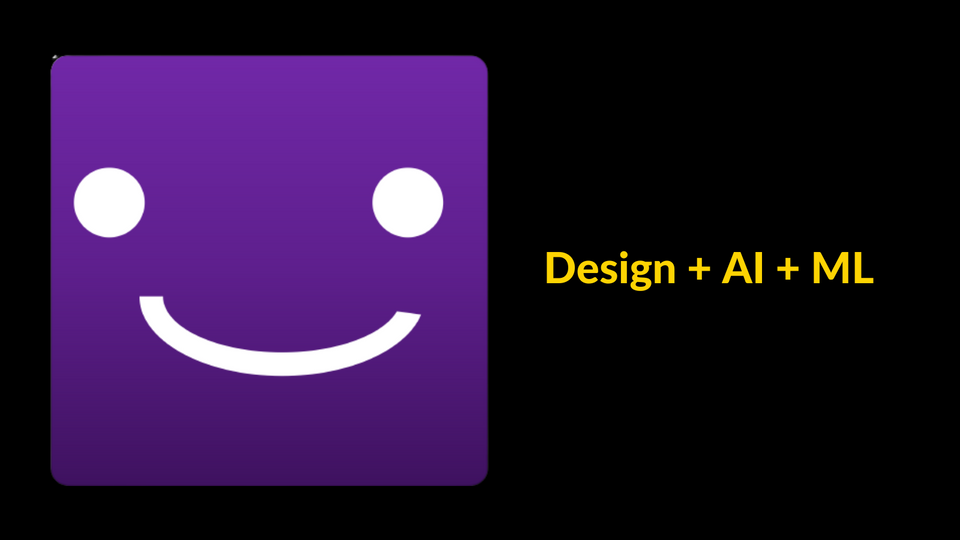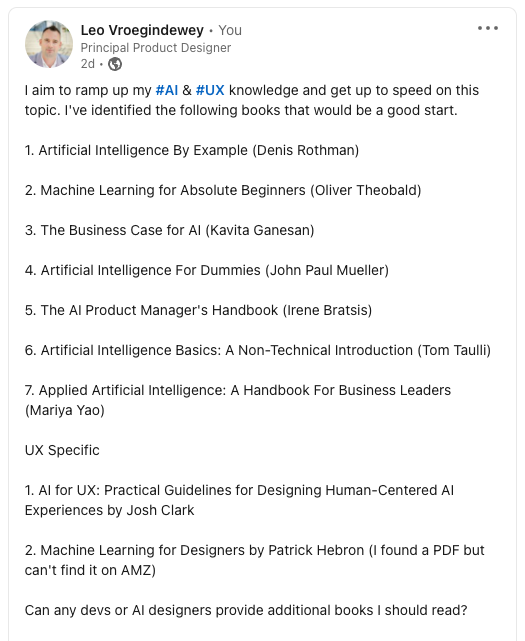My Introduction to Design AI and ML
Embarking on an AI and ML intro through nine books, aiming to fuse design thinking with AI and ML topics.

During the next several months, I will read about AI and ML and how I could design AI-powered user experiences in the future. I've ordered nine books that I think will help me provide an introduction to this deep and dense topic within tech.
See my LinkedIn post below. I intend to update this blog post over several months after reading all the books and hope to provide a summary of all of them.

Another Principal Designer sent me the link to this website and their substack. This website seems like a great resource for upskilling. However, I have not had a chance to review the site yet.

Learn to use AI to level up your design and advance your career
Introductory Books For the Designer On the Topics of AI and ML
I've purchased nine books I will read, and I hope they will form a good foundation for me as I jump into AI and ML. Patrick Hebron was kind enough to recommend two titles, and I also look forward to reading those books. Patrick Hebron is the author of Machine Learning for Designers, a classic, and I can't wait to dive in.
I've added the description from Amazon in case you want to read this list with me.
Artificial Intelligence For Dummies
This book will help you:
- Separate the reality of artificial intelligence from the hype
- Know what artificial intelligence can accomplish and what its limits are
- Understand how AI speeds up data gathering and analysis to help you make informed decisions more quickly
- See how AI is being used in hardware applications like drones, robots, and vehicles
- Know where AI could be used in space, medicine, and communication fields sooner than you think
If you think of yourself as not knowing much, it makes learning new topics much easier—less baggage and ego. I constantly have to tell myself I know very little, which keeps me curious.
Designing Human-Centric AI Experiences: Applied UX Design for Artificial Intelligence (Design Thinking)
You will learn:
- How to spot opportunities for applying AI in your organization.
- Advantages and limitations of using AI to solve problems.
- Best practices in UX design to build human-centric and ethical AI products.
- How to collaborate and communicate effectively with AI/ML tech teams.
This feels like it's right up my alley. Probably every designer should buy this book.
Artificial Intelligence Basics: A Non-Technical Introduction
This book will help you:
- It's a non-technical introduction to AI and the subsets of AI.
- Good introduction for beginners on the topic of AI.
Artificial Intelligence Basics has arrived to equip you with a fundamental, timely grasp of AI and its impact.
The AI Product Manager's Handbook: Develop a product that takes advantage of machine learning to solve AI problems
What you will learn:
- Build AI products for the future using minimal resources
- Identify opportunities where AI can be leveraged to meet business needs
- Collaborate with cross-functional teams to develop and deploy AI products
- Analyze the benefits and costs of developing products using ML and DL
- Explore the role of ethics and responsibility in dealing with sensitive data
- Understand performance and efficacy across verticals
I know - every year, I feel like a Principal Product Designer's role morphs closer to a Principal Product Manager and that eventually, we will all end up on the business team trying to figure out how to grow the sales revenue of a business.
Artificial Intelligence By Example: Acquire advanced AI, machine learning, and deep learning design skills, 2nd Edition
What you will learn:
- Apply k-nearest neighbors (KNN) to language translations and explore the opportunities in Google Translate
- Understand chained algorithms combining unsupervised learning with decision trees
- Solve the XOR problem with feedforward neural networks (FNN) and build its architecture to represent a data flow graph
- Learn about meta learning models with hybrid neural networks
- Create a chatbot and optimize its emotional intelligence deficiencies with tools such as Small Talk and data logging
- Building conversational user interfaces (CUI) for chatbots
- Writing genetic algorithms that optimize deep learning neural networks
- Build quantum computing circuits
I'm not going to lie - this sounds incredibly complex. I will have to find videos on YouTube to help me understand.
The Business Case for AI: A Leader's Guide to AI Strategies, Best Practices & Real-World Applications
What you will learn:
- What’s true, what’s hype, and what’s realistic to expect from AI and machine learning systems.
- Ideas for applying AI in your business to increase revenues, optimize decision-making, and eliminate business process inefficiencies.
- How to spot lucrative AI opportunities in your organization and capitalize on them in creative ways.
- Three Pillars of AI success, a systematic framework for testing and evaluating the value of AI initiatives.
Machine Learning for Absolute Beginners: A Plain English Introduction
Who is this for:
- You may want to read this book first. As a clear and concise alternative, this book provides a high-level introduction to machine learning, free downloadable code exercises, and video demonstrations.
- Machine Learning for Absolute Beginners Third Edition has been written and designed for absolute beginners.
I've played around with Python and Anaconda, but I like the sound of the author explaining machine learning to me like Im a golden retriever.
Plato and the Nerd: The Creative Partnership of Humans and Technology
From the author:
- Lee explores the ways that engineers use models and abstraction to build inventive artificial worlds and to give us things that we never dreamed of—for example, the ability to carry in our pockets everything humans have ever published.
- But he also attempts to counter the runaway enthusiasm of some technology boosters who claim everything in the physical world is a computation—that even such complex phenomena as human cognition are software operating on digital data.
This book is less about the technical aspect of AI and more of a discussion about how humans and technology interact. Patrick Hebron recommended this book.
From the author:
- The book also explores the future of generative AI and how individuals and companies can proactively begin to leverage this remarkable new technology to create competitive advantage.
Patrick Hebron also recommended this book and mentioned it would be an accessible book on the implementation side of AI.
Summary
My books will arrive in a few days, and I can't wait to dive in. A quick note about the price – yes, this book list will set you back about $300 - $400. I prefer to buy physical books because they increase my memory retention by about +20% versus Kindle editions.
Also, spending money on continued education and self-improvement is necessary to remain valuable to your employer and teammates. From my perspective, the underlying concepts remain the same in tech. Still, language and approaches may change. I think that is what AI and ML represent to people like myself who want to solve business problems by leveraging customers and making them pay for services and goods that translate into revenue for a business.
I realize this book list won't make me an expert in AI or ML as a designer, but it should form the foundation of my knowledge and point me in the right direction if you feel like I am missing books on this list. Contact me on my About page or hit me up on LinkedIn.
Written by Leo Vroegindewey, B2B CX Consultant
Get in touch to improve your customer experience and increase sales. Let's talk about how I can help your business grow. Email me.
